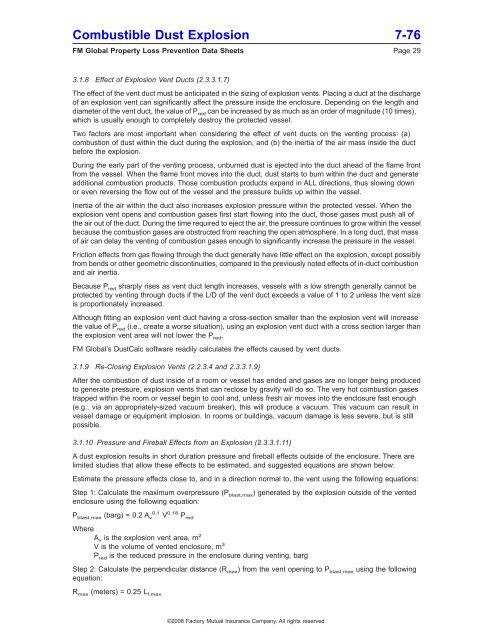DS 7-76 Prevention and Mitigation of Combustible Dust ... - FM Global
DS 7-76 Prevention and Mitigation of Combustible Dust ... - FM Global
DS 7-76 Prevention and Mitigation of Combustible Dust ... - FM Global
Create successful ePaper yourself
Turn your PDF publications into a flip-book with our unique Google optimized e-Paper software.
<strong>Combustible</strong> <strong>Dust</strong> Explosion 7-<strong>76</strong><br />
<strong>FM</strong> <strong>Global</strong> Property Loss <strong>Prevention</strong> Data Sheets Page 29<br />
3.1.8 Effect <strong>of</strong> Explosion Vent Ducts (2.3.3.1.7)<br />
The effect <strong>of</strong> the vent duct must be anticipated in the sizing <strong>of</strong> explosion vents. Placing a duct at the discharge<br />
<strong>of</strong> an explosion vent can significantly affect the pressure inside the enclosure. Depending on the length <strong>and</strong><br />
diameter <strong>of</strong> the vent duct, the value <strong>of</strong> P red can be increased by as much as an order <strong>of</strong> magnitude (10 times),<br />
which is usually enough to completely destroy the protected vessel.<br />
Two factors are most important when considering the effect <strong>of</strong> vent ducts on the venting process: (a)<br />
combustion <strong>of</strong> dust within the duct during the explosion, <strong>and</strong> (b) the inertia <strong>of</strong> the air mass inside the duct<br />
before the explosion.<br />
During the early part <strong>of</strong> the venting process, unburned dust is ejected into the duct ahead <strong>of</strong> the flame front<br />
from the vessel. When the flame front moves into the duct, dust starts to burn within the duct <strong>and</strong> generate<br />
additional combustion products. Those combustion products exp<strong>and</strong> in ALL directions, thus slowing down<br />
or even reversing the flow out <strong>of</strong> the vessel <strong>and</strong> the pressure builds up within the vessel.<br />
Inertia <strong>of</strong> the air within the duct also increases explosion pressure within the protected vessel. When the<br />
explosion vent opens <strong>and</strong> combustion gases first start flowing into the duct, those gases must push all <strong>of</strong><br />
the air out <strong>of</strong> the duct. During the time required to eject the air, the pressure continues to grow within the vessel<br />
because the combustion gases are obstructed from reaching the open atmosphere. In a long duct, that mass<br />
<strong>of</strong> air can delay the venting <strong>of</strong> combustion gases enough to significantly increase the pressure in the vessel.<br />
Friction effects from gas flowing through the duct generally have little effect on the explosion, except possibly<br />
from bends or other geometric discontinuities, compared to the previously noted effects <strong>of</strong> in-duct combustion<br />
<strong>and</strong> air inertia.<br />
Because P red sharply rises as vent duct length increases, vessels with a low strength generally cannot be<br />
protected by venting through ducts if the L/D <strong>of</strong> the vent duct exceeds a value <strong>of</strong> 1 to 2 unless the vent size<br />
is proportionately increased.<br />
Although fitting an explosion vent duct having a cross-section smaller than the explosion vent will increase<br />
the value <strong>of</strong> P red (i.e., create a worse situation), using an explosion vent duct with a cross section larger than<br />
the explosion vent area will not lower the P red.<br />
<strong>FM</strong> <strong>Global</strong>’s <strong>Dust</strong>Calc s<strong>of</strong>tware readily calculates the effects caused by vent ducts.<br />
3.1.9 Re-Closing Explosion Vents (2.2.3.4 <strong>and</strong> 2.3.3.1.9)<br />
After the combustion <strong>of</strong> dust inside <strong>of</strong> a room or vessel has ended <strong>and</strong> gases are no longer being produced<br />
to generate pressure, explosion vents that can reclose by gravity will do so. The very hot combustion gases<br />
trapped within the room or vessel begin to cool <strong>and</strong>, unless fresh air moves into the enclosure fast enough<br />
(e.g., via an appropriately-sized vacuum breaker), this will produce a vacuum. This vacuum can result in<br />
vessel damage or equipment implosion. In rooms or buildings, vacuum damage is less severe, but is still<br />
possible.<br />
3.1.10 Pressure <strong>and</strong> Fireball Effects from an Explosion (2.3.3.1.11)<br />
A dust explosion results in short duration pressure <strong>and</strong> fireball effects outside <strong>of</strong> the enclosure. There are<br />
limited studies that allow these effects to be estimated, <strong>and</strong> suggested equations are shown below:<br />
Estimate the pressure effects close to, <strong>and</strong> in a direction normal to, the vent using the following equations:<br />
Step 1: Calculate the maximum overpressure (P blast,max) generated by the explosion outside <strong>of</strong> the vented<br />
enclosure using the following equation:<br />
0.1 0.18<br />
Pblast,max (barg) = 0.2 Av V Pred<br />
Where<br />
A v is the explosion vent area, m 2<br />
V is the volume <strong>of</strong> vented enclosure, m 3<br />
P red is the reduced pressure in the enclosure during venting, barg<br />
Step 2: Calculate the perpendicular distance (R max) from the vent opening to P blast,max using the following<br />
equation:<br />
R max (meters) = 0.25 L f,max<br />
©2008 Factory Mutual Insurance Company. All rights reserved.

















